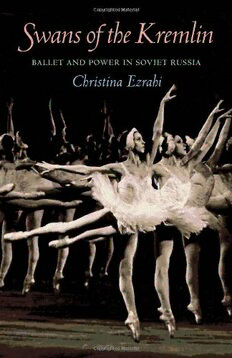
Swans of the Kremlin: Ballet and Power in Soviet Russia PDF
Preview Swans of the Kremlin: Ballet and Power in Soviet Russia
swans of the kremlin Pitt series in russian and east euroPean studies Jonathan Harris, Editor wans of the S Kremlin z ballet and Power in soviet russia Christina Ezrahi university of Pittsburgh Press dance books Published by the University of Pittsburgh Press, Pittsburgh, Pa., 15260 Copyright © 2012, University of Pittsburgh Press All rights reserved Manufactured in the United States of America Printed on acid-free paper 10 9 8 7 6 5 4 3 2 1 Published in Great Britain in 2012 by Dance Books Ltd., Southwold House, Isington Road, Binsted, Hampshire. GU34 4 PH Library of Congress Cataloging-in-Publication Data Ezrahi, Christina. Swans of the Kremlin : ballet and power in Soviet Russia / Christina Ezrahi. p. cm. — (Pitt russian east european) ISBN 978-0-8229-6214-4 (pbk.) 1. Ballet—Soviet Union—History. 2. Dance—Soviet Union—History. 3. Dance— Political aspects—Soviet Union. I. Title. GV1663.E97 2012 792.80947—dc23 2012030694 CIP catalog record is available from the British Library ISBN 978-1-85-273158-8 To Ariel, Lina, and Yariv Contents Acknowledgments ix A Note on Transliteration and Translation xi Introduction 1 1. Survival: The Mariinsky and Bolshoi after the October Revolution 10 2. Ideological Pressure: Classical Ballet and Soviet Cultural Politics, 1923–1936 30 3. Art versus Politics: The Kirov’s Artistic Council, 1950s–1960s 67 4. Ballet Battles: The Kirov Ballet during Khrushchev’s Thaw 102 5. Beyond the Iron Curtain: The Bolshoi Ballet in London in 1956 137 6. Enfant Terrible: Leonid Iakobson and The Bedbug, 1962 169 7. Choreography as Resistance: Yuri Grigorovich’s Spartacus, 1968 201 Conclusion 232 Appendix 1: A Who’s Who 241 Appendix 2: Ballets 257 Notes 273 Bibliography 301 Index 309 vii Acknowledgments The sublime dancers of the Mariinsky-Kirov and the Bolshoi, who elevated the art of ballet throughout the tumultuous twentieth century, inspired this research. I would like to thank the staff at the Central State Archive of Liter- ature and the Arts in St. Petersburg and of the Russian State Archive of Lit- erature and the Arts in Moscow. Ballet is a visual art, and this book would not have been the same without the help of Natalia Metelitsa, Tatiana Vlaso- va, and Sergei Laletin from the St. Petersburg State Museum of Theater and Music, Elena Lollo, Alisa Meves, Elena Mochalova, and Olga Ovechkina from the Mariinsky Theater, and of Gwyneth Campling and Victoria Relph from the Royal Opera House, Covent Garden, who helped me obtain pho- tographs for this book. I am grateful to the dancers of the Kirov and Bolshoi Ballet companies who have shared their thoughts with me over the years, above all Makharbek Vaziev, Olga Chenchikova, and Evgeny Goremykin. I thank my editor, Peter Kracht, for his guidance and his enthusiasm about this project, which began at University College London’s School of Slavonic and East European Studies. I am indebted to Alena Ledeneva and Geoffrey Hosking for their inspiring guidance and to Nancy Condee for her support. I would like to thank the Arts and Humanities Research Council and University College London for funding my work. I am deeply grateful to my mother for sharing my love for Russian bal- let and to my father for putting up with our enthusiasm. I am obliged to my parents-in-law, especially Sidra DeKoven Ezrahi and Ruth HaCohen, for nurturing me intellectually and gastronomically, but notably to Yaron Ez- rahi, who has provided invaluable guidance at different stages. Above all, I would like to thank my husband, Ariel, who has become an expert on Rus- sian ballet, my daughter, Lina, whose first words included Mariinsky and Bolshoi, and my son, Yariv, who chivalrously accompanied me to St. Peters- burg even before he was born. ix
